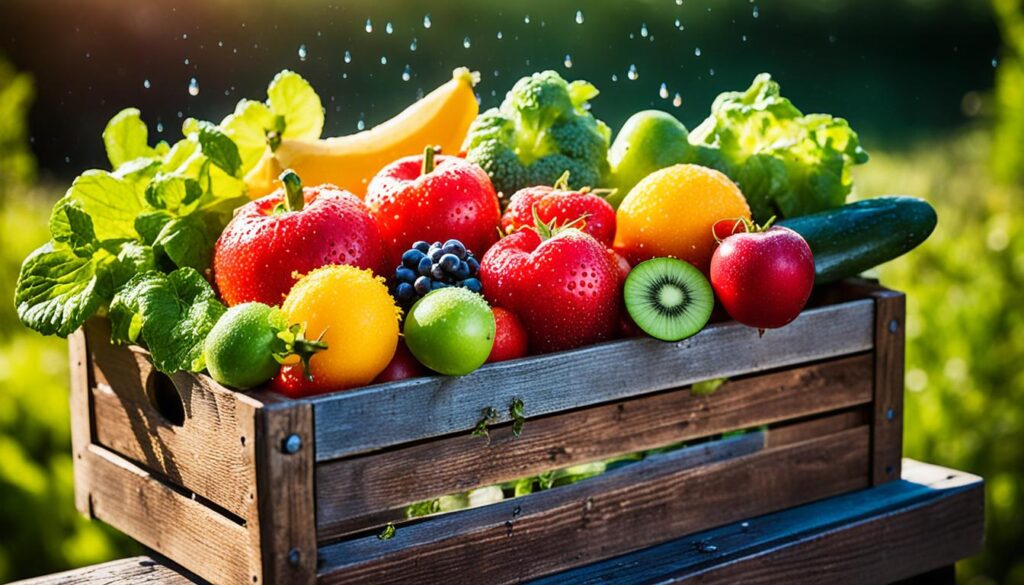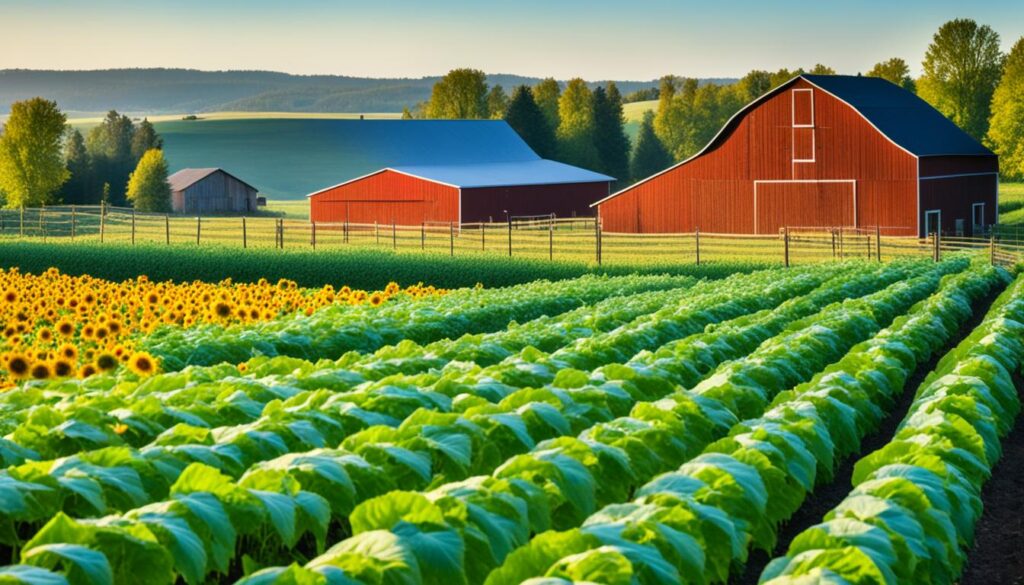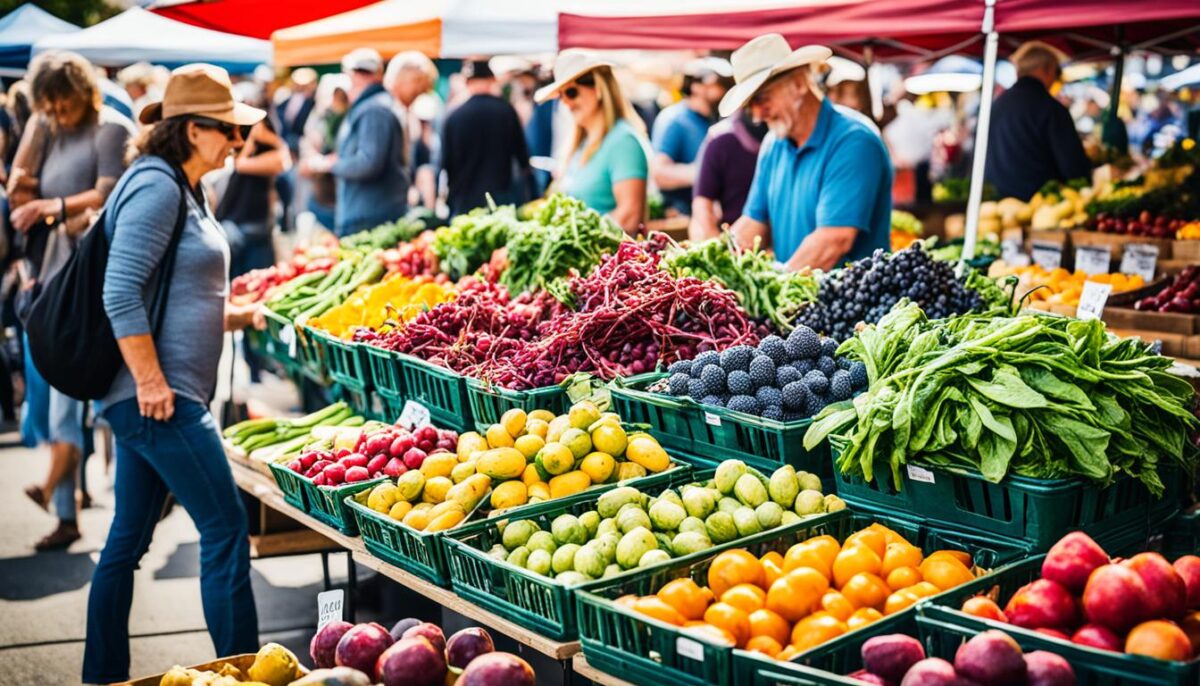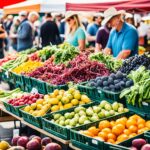Imagine a juicy peach, bursting with sweet flavor, or the crunch of a fresh carrot. Locally grown produce offers real taste, unlike the store’s bland offerings. You may wonder where to find this amazing food. The answer is in local farmers markets, CSA programs, and U-pick farms all over the United States. Have you thought about how to enjoy such quality, locally sourced food?
The Eat Well Guide is an online tool that helps you find fresh, locally-grown food in the U.S. and Canada.1 Local Harvest also lets you look for farmers markets and family farms near you. It offers a range of locally grown or produced items, from fruits and vegetables to meats.1 Plus, the USDA Farmers Market Search lets you find markets near you, and American Indian Foods lists Native American food sources.1 With these tools, discovering the finest, tastiest produce is easy.
Key Takeaways
- Explore the wealth of local farmers markets, CSA programs, and U-pick farms for the freshest, most nutritious produce.
- Discover online directories like the Eat Well Guide and Local Harvest to find sources of sustainably grown food in your area.
- Learn about the USDA Farmers Market Search and American Indian Foods directory to access even more options for locally sourced goods.
- Embrace the farm-to-table movement and support your local agricultural community by sourcing your produce from these vibrant, community-based sources.
- Enjoy the peak flavors and maximum nutritional benefits of seasonal, locally grown fruits and vegetables.
The Importance of Fresh, Local Produce
A diet packed with fresh produce is key to staying healthy. It’s especially important for fighting cancer or preventing it. A diet that focuses on plants and includes lean proteins and colorful fruits and veggies boosts the immune system. It also helps fight inflammation and protects cells from harm. Texas is a great place to find local, healthy foods. There are many farmers markets that offer fresh, nutritious produce and other goods. By shopping at these markets, you support both local farmers and the environment.2
Nutritional Benefits
Choosing locally grown food means you get more nutrients. Vitamins and other healthy parts of food start to go away as soon as plants are picked. This makes it very important to eat fruits and vegetables when they are the freshest. That’s why local produce is often healthier than items shipped from far away.23
Supporting Sustainable Agriculture
Local farmers take care of the land by growing food without harmful chemicals. This helps keep our environment clean. Also, their work protects natural areas and offers homes for wildlife. Buying local food not only supports the environment but also creates jobs. This boosts the local economy and helps everyone in the community.3
Seasonal Flavors at Their Peak
Have you noticed that local food often tastes better? That’s because it’s in season and very fresh. Buying from farmers markets not only gives you amazing flavors but also helps local farmers and businesses thrive.2
Finding Local Farmers Markets
In North Texas, you can enjoy many farmers markets. They are filled with fresh, locally grown produce and artisanal goods. Notable markets to visit are the Coppell Farmers Market and the Dallas Farmers Market. Plus, there’s the Frisco Rotary Farmers Market and Lola’s Local Market.4 At these spots, you’ll find lots of fruits and vegetables, meats, and eggs.
Online, you can use tools like the Eat Well Guide to find local produce.5 There’s also the Local Harvest directory and the Certified Naturally Grown map. These sites help you discover farmers and shops in your area selling locally sourced food.
Community-Supported Agriculture (CSA) Programs
CSA programs are another great option. Green City Market and others offer this.5 By joining, you directly support local farmers. Plus, you get a regular supply of nutritious foods for your family.
Fresh Produce: Discover Locally Grown Goodness
The local farmers markets in North Texas have a lot to offer. You can buy fresh fruits and vegetables right from the source. They have everything, like certified organic leeks and homemade guacamole. Plus, you’ll find organic and pesticide-free options.3 Shopping here lets you meet the farmers and support how they grow food. This means you get the best, most nutritious produce while helping your community.
Variety of Fruits and Vegetables
In North Texas, local markets are packed with delicious, seasonal foods. You’ll see fresh greens, ripe berries, and colorful roots. If you’re looking for specific items like heirloom tomatoes or sweet peaches, these markets are perfect.6 Enjoying this variety means your meals will be full of important vitamins and minerals.
Organic and Pesticide-Free Options
These markets also sell certified organic and pesticide-free options.3 These foods are grown without harmful chemicals, which is good for the planet and you. Choosing these items means you’re supporting farming that cares about the environment. And, it’s a great choice for your health.
Farm-to-Table Movement
https://www.youtube.com/watch?v=R3LzK9e0Qyw
The farm-to-table movement is getting more popular. People want to know where their food comes from. They want to help local farmers.7 You can do this by shopping at farmers markets or joining community-supported agriculture (CSA) programs. This way, you meet the farmers who grow your fresh produce and local vegetables.7
Buying local not only gives you the best tasting food. It helps your community too. Your money supports your local economy by staying within your area.7
Connecting with Local Farmers
Buying from local farmers helps small, family farms stay in business. It also protects the traditional farming ways of your area.7 The idea of getting food straight from the farm started in the 1960s and 70s on the West Coast. Now, it’s a big deal everywhere.7
Supporting Local Economies
The farm-to-fork trend really boosts local economies and helps local farmers.7 But eating food that comes directly from farms can cost more. The bills are higher because these places have more expenses. They have to get back the money they spend on providing you with good, local food.7
But, people are still excited about the farm-to-table movement.7 It started growing in the 1900s and became really popular in the 2000s. More and more folks want food that’s healthy and good for the environment. Because of this, the need for pesticide-free produce keeps going up.7
Seasonal Produce Guide
Local farmers markets in North Texas have a wide variety of produce. They change with the seasons, offering fresh options all year.8
Spring Harvest
Spring brings fresh greens, radishes, and asparagus.8 It’s a time for enjoying strawberries, ramps, and asparagus until mid-May.9
Summer Bounty
In the summer, markets abound with tomatoes, corn, and peaches.8 You’ll also find berries, peaches, and plums at their ripe best.9
Fall Favorites
Autumn showcases squash, apples, and pumpkins.8 It’s a chance to enjoy apples, pears, and figs along with pomegranates.9
Winter Gems
Even in winter, markets have root veggies, citrus, and greens.8 Look for pomelos, blood oranges, and root veggies like rutabagas.9
Shopping seasonally means you enjoy the best flavors and nutrition.8 It’s also better for the environment and your health.9
| Season | Produce |
|---|---|
| Spring | Greens, radishes, asparagus, ramps, strawberries |
| Summer | Tomatoes, corn, peaches, berries, stone fruits |
| Fall | Squash, apples, pumpkins, figs, pomegranates |
| Winter | Root vegetables, citrus fruits, hardy greens |
Storing and Preparing Fresh Produce

Getting the best from your fresh, local produce means knowing how to store and prepare it. Storing some in the fridge and keeping others at room temperature helps keep them fresh.10 Apples can stay good for weeks, pears for up to two weeks, and peaches for about a week.10 Asparagus lasts about a week when stored right,10 and celery can last a few weeks.10 Putting avocados in the fridge can help them last longer.10
Proper Storage Techniques
Broccoli and cauliflower stay fresh for two weeks in the fridge, while cabbage lasts up to three.10 Romaine and green leaf lettuces can last about a week.10 Sweet potatoes stay good for one to two weeks, and regular potatoes a bit longer.10 Tomatoes last between one to two weeks, depending on their ripeness and how they’re stored.10 Knowing how to store different fresh produce helps keep them fresh and packed with nutrients.
Simple and Delicious Recipes
Along with storing food right, there are great recipes to try. Things like roasted veggies, fresh salads, and smoothies showcase the best of each season. By using what’s available at local markets and CSA programs, you get to taste the peak flavors. Plus, your body benefits from the natural ingredients that are good for you.
Health Benefits of Fresh Produce
Eating a lot of fresh, locally grown produce is great for your health. These items contain antioxidants and phytochemicals. These can improve your immune system, reduce inflammation, and prevent DNA harm.11 They also help with blood pressure, lower cancer risk, and make your gut better. They even boost memory and help you manage your weight. Plus, they keep your bones and teeth healthy.11 The antioxidants in fresh fruits and vegetables protect your cells. This helps lower the risk of cancer.11
Antioxidants and Phytochemicals
Fiber-rich foods such as vegetables and fruits can help lessen depression, tiredness, and the chance of getting too heavy.11 Eating fresh produce instead of processed foods reduces caloric intake. It also provides more fiber.11 Foods from local farms are safer because they don’t have extra chemicals.11 Such foods help you sleep better by making you less hungry. This is thanks to their high fiber content.11 Minerals from fresh produce like magnesium and calcium support healthy bones and teeth.11
Disease Prevention and Management
Fresh fruits and vegetables from sources like Common Ground Producers and Growers in Wichita, Kansas, don’t just taste good. They are also very nutritious.1112 This group is famous for providing natural fresh produce. This helps people eat healthier.11 Eating plant-based foods is crucial for cancer patients, people in remission, and those aiming to prevent it. A diet full of fresh, locally sourced fruits and vegetables can keep you healthy and help with treatments.
Local Farms and U-Pick Adventures

Shopping at local farmers markets is great. But, you should also check out the family-owned farms in North Texas. Many let you pick your own fruits and veggies.13 You get to experience the top freshness of what local farms grow. Also, you help in supporting nature-friendly agriculture and get closer to the earth.13
Farm Tours and Educational Opportunities
These farms don’t just let you pick your own. They also offer tours and workshops. You can learn how they grow things, about sustainable farming, and the importance of home-grown foods.13 This way, you know more about the food on your table and its journey from the farm.13
Whether you’re collecting your own organic fruits and local veggies or learning about farming, it’s an amazing way to connect with nature. It helps you appreciate what each season brings and backs the farmers market idea.13
Farmers Market Etiquette
Shopping at local farmers markets means embracing good manners and helping the vendors.14 Respect the vendors by asking them about how they farm. Also, try new items they offer.15 It’s great to use your own bags, buy only what you need, and choose items in eco-friendly packaging.15 These actions make your visit to the market enjoyable for you and a support for the local farmers.
Supporting Local Vendors
Meeting local farmers and vendors lets you learn about fresh food and help the earth too.14 Talk to the farmers, ask about how they grow food, and applaud their work.15 This makes friendships and supports small, local farms, which are key to our community’s food supply.
Sustainable Shopping Practices
At the farmers market, choose green shopping habits that are good for the planet.14 Use your own bags to reduce plastic use and pick only what you need to cut down on waste.15 Also, prefer items with packaging that’s easy on the environment. Help these eco-minded sellers make a difference.15 Your choices can help make the food system better for the earth.
Incorporating Fresh Produce into Your Diet
Eating fresh, local fruits and vegetables is tasty and good for you.12 It can help you manage your weight and energy better.12 Also, eating more of these plants can help you lose weight and fat when trying to slim down.12 Try to eat a mix of fruits and veggies throughout the year. You can cook them in simple ways, like roasting or sautéing, to keep the flavor and nutrients high.
Meal Planning and Preparation Tips
The American Heart Association says we should eat a lot of fruits and veggies every day.16 Try to make half your meal fruits and veggies.16 Having frozen veggies ready to use can be a big time-saver.16 Adding more veggies to dishes like soups or stews boosts their healthiness.16 Plus, making extra veggies means you’ll have some for later meals, too.
Family-Friendly Recipes
There are lots of recipes that your whole family will love. You can make colorful salads, warm soups, tasty stir-fries, and cool smoothies.12 Eating these meals can help lower certain health risks in overweight women.12 Also, a diet with lots of fruits can help women eat less and shed some pounds.12 Using fresh, local produce in your daily meals and snacks is a great idea. It lets you enjoy the best tastes of the year. Plus, it supports the farmers in your area and is good for the planet.
Conclusion
In North Texas, enjoying fresh, locally grown produce is both tasty and good for you. It helps the community too. Visit farmers markets, join CSA programs, or take trips to local farms. This way, you get to know where your food comes from, savor peak seasonal flavors, and help small family farms stay afloat.17 Including fresh, locally sourced fruits and vegetables in your meals is a smart move, whether you want to stay healthy, cope with illness, or simply taste the best of what nature has to offer.
Eating a lot of fresh produce brings loads of health benefits. It also supports sustainable farming and keeps your local food history alive.18 By cutting down on food waste and lowering the fuel needed to bring food to your plate, you help the planet and keep the local food cycle going strong.19
Exploring farmers markets and enjoying u-pick adventures in North Texas lets you dive into your community. You’ll find plenty of seasonal crops and get a taste of the farm-to-table life. There’s loads of organic, pesticide-free produce out there, ready for you. This is not only good for your health but also for building a sustainable future for your local food scene.
FAQ
What online resources can I use to find local farmers markets and sources of fresh, locally-grown produce?
The Eat Well Guide and Local Harvest are helpful for finding local farms and markets. The USDA Farmers Market Search is great for pinpointing farmer’s markets. If you’re looking for unique foods, American Indian Foods can guide you.
How can eating a diet rich in fresh, locally-grown produce benefit my health?
A diet full of fresh produce brings great health benefits. This is super important for cancer fighting and prevention. These foods are rich in antioxidants and phytochemicals. They boost our immune system, cut inflammation, and protect our DNA.
What are some of the notable farmers markets in the North Texas area?
In North Texas, you’ll find several great farmers markets. The Coppell and Dallas Farmers Markets are big hits. Also, don’t miss the Fairview Farms Marketplace and others like the Farmers Market of Grapevine and McKinney Farmers Market.
What kind of produce can I find at the local farmers markets in North Texas?
North Texas markets have a broad range of farm-fresh produce. A lot is locally grown, some even certified organic. You’ll find a little of everything, from seasonal greens to tomatoes, and sweet corn. Plus, they offer pesticide-free options.
How does buying from local farmers markets and CSA programs support sustainable agriculture and local economies?
At farmers markets and CSAs, you meet the folks who grow your food. This direct approach means you get the tastiest, freshest produce. It also keeps money circulating in your local area. This supports the community and sustainable farming practices.
What are the health benefits of incorporating fresh, locally-grown produce into my diet?
Local, fresh produce is a goldmine for health. It boosts the immune system. Also, it helps with inflammation and can keep cancer at bay. That’s because of the antioxidants and other healthy compounds found in these foods.
What are some tips for properly storing and preparing fresh, locally-grown produce?
To preserve your produce’s quality, knowing how to store it is crucial. Some things need the fridge, while others do best at room temperature. As for cooking, simple recipes are best to bring out their natural flavors.
What are some important etiquette guidelines to follow when shopping at local farmers markets?
Be polite and curious when talking to market vendors. Ask them about their farming methods. And be open to trying new foods. It’s also great to bring your own bags and look for eco-friendly packaging. This small step helps the environment.
Source Links
- https://www.farmaid.org/find-good-food-from-family-farmers/
- https://wholesomestory.com/blogs/wholesome-journal/fresh-and-local-10-reasons-why-buying-locally-produced-food-is-important
- https://www.hhfb.org/news/the-importance-of-fresh-local-produce/
- https://www.usda.gov/our-agency/initiatives/usda-farmers-market
- https://sustainableagriculture.net/blog/national-guide-to-finding-local-food/
- https://www.harvestforyou.com/pressmedia/why-does-farm-fresh-food-taste-so-great/
- https://www.webstaurantstore.com/blog/4336/farm-to-table-meaning.html
- https://www.usfoods.com/content/dam/usf/pdf/produce/Freshness-Guide.pdf
- https://www.marthastewart.com/8383524/seasonal-produce-guide
- https://foodinsight.org/how-to-store-fresh-produce/
- https://commongroundpg.com/farm-fresh-foods/
- https://www.ncbi.nlm.nih.gov/pmc/articles/PMC4644575/
- https://www.calvertcountymd.gov/3266/Farm-Adventures
- https://www.cuisinenoirmag.com/farmers-market-etiquette/
- https://chicago.eater.com/2024/4/19/24135188/chicago-farmers-market-tips-ettiquite
- https://www.heart.org/en/healthy-living/healthy-eating/add-color/how-to-eat-more-fruits-and-vegetables
- https://cannoncentral.com.au/here-are-important-things-you-need-to-know-about-fresh-produce/
- https://www.sciencedirect.com/topics/agricultural-and-biological-sciences/fresh-vegetable
- https://research.wri.org/wrr-food/conclusions-synthesis

